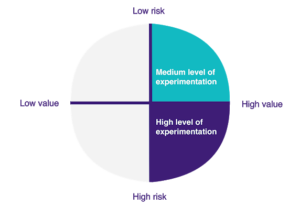Does your solution need experimentation?
Though new projects begin with ideas based on assumptions—what we think we know. You might have a world-changing product, but it can still fail in the market! Not because of technology, or not getting the business model right, but just because you did not validate your business idea assumptions. The term “leap of faith” is often used to describe product developments that contain dangerous assumptions. Taking the risk that if assumptions turn out to be false, the idea fails – and therefore wasting expensive development efforts.

Here a helpful rule-of-thumb to know if your idea needs experimentation
We asked ourself question on what might happen if our assumption turned out to be wrong? What would be the impact on the outcome? Often we flagged assumptions as “risky” depending on the cost of your investment – the higher the costs, the higher the impact if we found out, in the end, our assumptions were wrong. We used a simple matrix, as you can see here. Once we identified our assumptions, it was 30 minutes to get together to decide where our assumptions lived within the matrix. Simple, but soo useful.
Once we concluded that the risks were too high, we decided to invest in experimentation and reduce the risk by creating early feedback loops. In most cases already during the exploration phase, before the business made any significant investment in a solution. It also ensures good experience outcomes for our users.
Validate assumptions in the quickest, cheapest way. Keep it lean!
Unnecessary work is the enemy of efficiency. In most “lean” practices, we call this “waste.” Aesthetics, for example — in the visual design sense — are an essential part of a finished product and experience and, in most cases, not needed to validate an assumption. By sacrificing the “perfection” of intermediate design artifacts, my teams were able to ship faster and learn more quickly.
Once assumptions are validated, and you’re at the visual design stage, there is the chance to validate and test the result of the visual elements that exist in the user experience (design, workflow, copy, content, performance, value propositions, etc.). Learn which are working for the users and which aren’t — first focus on validating idea assumptions.
And lastly, learning that we were wrong early and quickly in the process, wasn’t hard for the team to accept. Actually, in most cases, valuable learnings were celebrated, and the team was motivated to make changes and rework our ideas.
